Animal Health and Welfare (Scotland) Act 2006: analysis of consultation responses
Summary of responses to our consultation on proposals to increase maximum penalties, speed up process for making permanent arrangements for seized animals and giving power for fixed penalty notices.
Section 2: Analysis of Responses
Summary of Respondents
Figure 1 - Breakdown of the number of responses from respondent groups
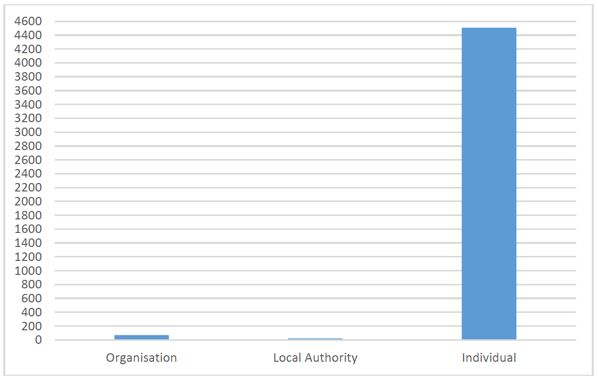
A total of 4,595 responses were received. Of these 69 were from groups or organisations which included: animal welfare organisations, animal sanctuaries, animal rehoming centres, veterinary professionals, legal professionals, agricultural businesses, animal breeders and enforcement agencies. In addition, 20 responses were received from local authorities (LAs) and the remaining 4,506 were from members of the public with an interest in the welfare of animals.
Question 1: The Scottish Government proposes that the maximum penalties for the most serious animal welfare offences should be strengthened. Do you agree?
Figure 2 - Breakdown of respondent groups to question 1 (%)
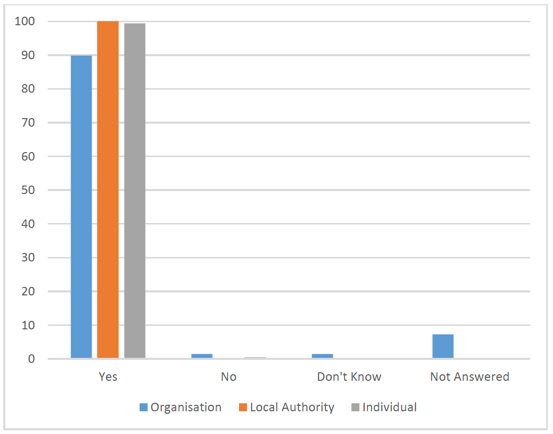
Overview
A total of 4,588 respondents answered this question. Of those who answered, 99.4% agreed with the proposal to strengthen the maximum penalties for the most serious animal welfare offences while, of those who answered, 0.5% did not agree.
Separating responses by respondent type showed that the vast majority of organisations and individuals, and all LAs agreed with the proposal.
Those that agreed
The key themes in the individual responses, of those who answered positively to the proposal, were; it was believed that the current maximum penalties are too low; the current sentencing does not act as a deterrent; there is a link between domestic abuse and violence towards animals; animals cannot speak for themselves or defend their interests as effectively as humans can and that animal sentience should be reflected more in legislation.
Of the organisations in favour of the proposal, the most common theme was that courts would have more options and so would have the opportunity to award longer sentences. The respondents hoped that tougher sentencing and harsher penalties would act as a deterrent for animal abusers. Many respondents suggested that increased maximum penalties would lead to a reduction in abuse cases.
Amongst those in support of the proposal, concerns were raised about the length of the current maximum penalties.
'…sentences of only 12 months for very serious abuse of animals does not reflect these concerns appropriately and trivialises the extent of suffering…' (Jeanne Marchig International Centre for Animal Welfare Education)
Some respondents commented that there should be careful consideration about which cases were deemed to be the 'most serious', to ensure that penalties are appropriate. Local authorities in favour of the amendment felt that it would address public concern and act as a deterrent. Additionally, it was suggested that increased penalties would reflect the seriousness of any offences. Another common theme amongst local authorities was that the amendment would see Scottish legislation matching other countries with similar maximum penalties.
'…An increase in the prison sentence from 12 months to 5 years would bring Scotland into line with Northern Ireland…'(Aberdeenshire Council)
Those that disagreed
Of the small number of people who disagreed with the proposal the main concern was that there was no evidence to suggest that tougher penalties would indeed act as an effective deterrent.
'We feel the penalties are already sufficient. The consultation merely asserts, without any evidence, that the current regime is not a deterrent' (The Scots Fancy Specialist Club)
Question 2 – Do you agree that the maximum prison sentence available for offences under section 19 (unnecessary suffering) and section 23 (animal fighting) should be increased from twelve months to five years imprisonment?
Figure 3 - Breakdown of respondent groups to question 2 (%)
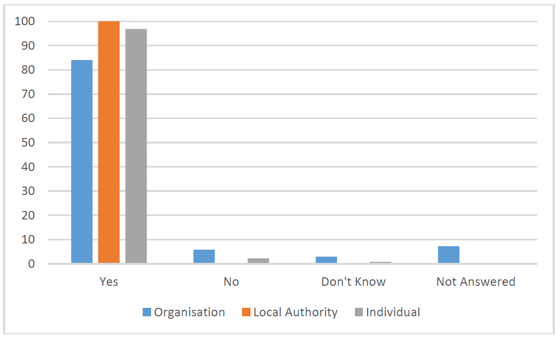
Overview
A total of 4,583 responses were received for this question, 96.9% agreed with the Scottish Government's proposal to strengthen the maximum prison sentence available for offences under section 19 (unnecessary suffering) and section 23 (animal fighting) by increasing the maximum sentence from twelve months' to five years' imprisonment. Of those who answered, 2.3% did not agree.
Of the 69 organisations who participated in the consultation, 58 respondents (90.6%) agreed with the proposed increased maximum prison sentence with 4 (6.3%) disagreeing.
All 20 LAs who participated in the consultation agreed with the proposed increased maximum prison sentence.
Of the 4,506 individuals who participated in the consultation, 4,364 (97%) agreed with the proposed increased maximum prison sentence with 100 (2.2%) disagreeing.
Separating the responses by type showed that an overwhelming number of organisations and individuals agreed with the proposal and that the local authorities were unanimous in their agreement.
Of the individuals who answered, the common themes were; increasing the length of imprisonment would act as a deterrent; the current maximum prison sentence available was too low; the proposed increase in length of imprisonment should be lengthened further and it was implied that it was the mark of a 'civilised society' to take animal welfare seriously by increasing the maximum penalties.
Those that agreed
Of those organisations in favour of the proposed increased maximum prison sentences the belief that strengthening the sentencing would act as a deterrent was again highlighted and the current length of maximum sentencing was criticised.
'12 months is simply not enough of a deterrent.' (Edinburgh Dog and Cat Home)
The LAs in favour of the proposed increased maximum prison sentence underlined that, although higher maximum penalties would be available, they may not always be necessary in every circumstance.
'By increasing the sentence it brings the punishment available to be more in line with the seriousness of the offences. The maximum would not always be required to be used but in cases where the welfare issues are extreme then the appropriate sentence is available' (Argyll and Bute Council)
Those that disagreed
Of those not in support of the proposed increased maximum prison sentence the concern was that tougher penalties would impose additional strain on prison services and would demand increased public funding.
'Actually I'd prefer to punish these offenders in ways that don't cost the public money. Ban them from ever keeping animals (their whole life). Make them do community service. Make them pay money every month to animal welfare charities' (Blantyre Community Council)
One 'Not Answered' response was that an act of cruelty is not clearly defined, but tougher sentencing should only be awarded for the most serious offences involving acts of cruelty.
Question 3 – Do you agree that there should be no upper limit on fines for offences under section 19 (unnecessary suffering) and section 23 (animal fighting)?
Figure 4 - Breakdown of respondent groups to question 3 (%)
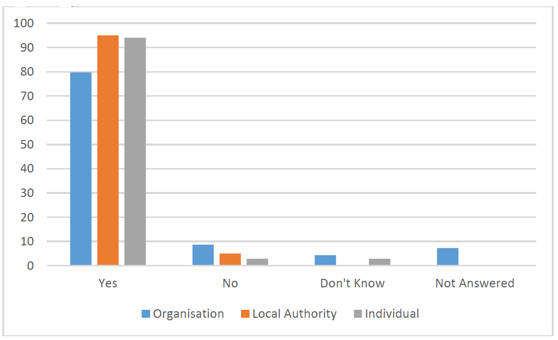
Overview
4,576 respondents provided responses on whether or not they thought that there should be no upper limit on fines for offences under section 19 (unnecessary suffering) and section 23 (animal fighting).
A majority (94.1%) of respondents who answered supported the idea that there should be no upper limit on fines for offences under section 19 (unnecessary suffering) and section 23 (animal fighting). 3% of respondents who answered did not agree with the proposal.
Separating responses by respondent type showed that, of those who answered, the vast majority of organisations (85.9%) and individuals (94.3%) agreed with the proposal while (95%) of LAs agreed with the proposal.
Key themes from individual responses included; the view that people are inherently money driven and that targeting the cash flow of an individual would be an effective deterrent; prison sentences or community service may be more effective; fines should increase every year and concerns were raised about those who would be unable to pay the fine.
Some of the other views expressed overall included; the idea that the fines given should reflect the nature and severity of the crime; fines should always be a sizeable amount in order to create an impact; fines should reflect the income of the individual and that in cases where the perpetrator has made financial gains or profited from the crime the fine should reflect the level of profit made.
Those that agreed
Some respondents that agreed expressed concern as to why some fines currently awarded were low in comparison to others. The belief was expressed that by eliminating an upper limit there would be more option for the courts to award a larger fine which would reflect the magnitude of the public concern more.
'Actual fines are routinely more like a few hundred pounds. This level of sentencing does not reflect public expectations of justice for animals and the aim of increasing fines would be to encourage the courts to fine offenders more heavily… allowing for an unlimited fine will emphasise the gravity of animal cruelty and the public's expectation that it will be dealt with severely, thus encouraging the courts to sentence more appropriately' (OneKind)
However, a number of organisations in favour also expressed concerns in their response. It was noted by some respondents that bans from keeping animals would be more appropriate if used in tandem with fines in certain cases.
'Removing the upper limit on fines allows the judiciary some flexibility in such cases. However we believe this should be considered in conjunction with the appropriate use of bans from animal-keeping…' (Redwings Horse Sanctuary)
Of those LAs in favour of the proposal, it was noted that large fines would be a suitable option for certain crimes where the perpetrator has profited from the crime.
'We would also welcome the use of Proceeds of Crime legislation to confiscate illegal earnings associated with activities such as dog fighting' (Stirling Council)
Another common theme was that the proposal would not only be a deterrent but would also again give the courts more options in terms of sentencing. It would allow the courts to award penalties appropriate to the magnitude of the crime.
Those that disagreed
Of those not in support of unlimited fines there was concern that they would not act as a deterrent if the perpetrator is not in a stable financial position and cannot pay the fine. Additionally, it was highlighted by respondents that imposing a fine devalues the concept of animal sentience.
'If an abuser is of limited or low income then a fine has absolutely no meaning to them at all. …To increase fines also implies that the animal is viewed in pure monetary terms' (Finns Law Ltd)
It was also pointed out by a respondent that, in a case where a large fine could be imposed, other sentencing options may be the first choice. The respondent suggested this could make the option of a larger fine redundant.
'… Fines are not used by the courts as alternatives to sentences of imprisonment…Any fine that is imposed in any case would need to be commensurate with the means of the convicted offender. Maintaining the current maximum penalty would not exclude other sentencing options...' (The Law Society of Scotland)
Question 4 – Other than increasing the maximum penalties for unnecessary suffering; should we amend legislation in any other ways, in regard to attacks on service animals?
Figure 5 - Breakdown of respondent groups to question 4 (%)
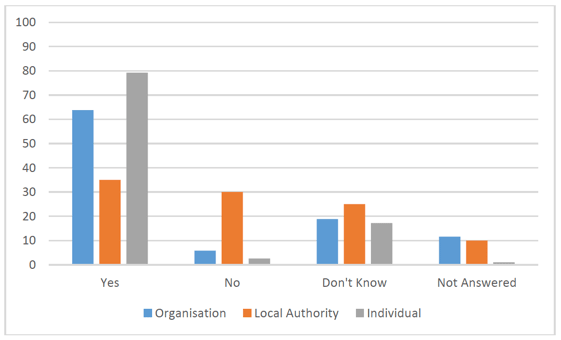
Overview
A total of 4,539 responses were received for this question. 79.8% respondents agreed that further amendments were required, in addition to increasing the maximum penalties for unnecessary suffering, in regard to attacks on service animals. Meanwhile 2.8% of respondents disagreed with amending legislation in other ways, in regard to attacks on service animals.
Separating responses by respondent type showed that the majority of organisations (72.1%) and individuals (80%) who answered wanted further amendments. The local authority responses were varied with 35% of LAs wanting further amendments, 30% against, 25% Didn't Know and 10% did not answer.
Key themes in the individual responses included; harming a service animal has the same implications as harming the handler; service animals are defenceless; service animals may be on the front line and hence an easy target; owners may be reliant on the service animal and again the issue of animal sentience was raised. Of the individuals against further amendments, the argument was raised that the legislation should be the same for all animals.
Respondent suggestions as to how to amend the legislation included; using fines as a deterrent, use of community service as a punishment, the use of an offenders register (perhaps specific to attacks on service animals) and to implement similar 'Finn's Law' legislation that has recently been initiated in England and Wales.
Those that agreed
Of those organisations in favour a key respondent appeared to be organisation 'Finns Law Ltd'. The organisation highlighted that animals used in the police force are trained to attack as part of their duty of service. This then subjects them to a higher degree of danger in this setting.
'Animals such as Police Dogs and Horses and Prison Dogs…work in some of the most hostile and violent environments to support their handlers and riders in carrying out duties to protect society.' (Finns Law Ltd)
The concern that the sentience of the animal is not specifically considered in legislation is also raised by other respondents. This is raised parallel with the concern that there is a conflict in the current legislation between the maximum possible prison sentences available under the animal welfare legislation and the Criminal Damage Act 1971.
'Since animals used by the police or military are sentient beings, not government property, these offences should fall under the strengthened animal-welfare legislation, rather than being considered criminal damage' (PETA Foundation)
Of the local authorities in favour, a common theme was that the definition of what constitutes a 'service animal' should be outlined. Moreover, respondents discussed the fact that, in the cases where service animals have been attacked, the perpetrator may claim they acted in self-defence. At least one respondent suggested that tougher legislation, by means of perhaps amending the Act to remove the legal defence of 'self-defence' against a service animal, to protect these animals may prevent such claims.
'Finn's Law' – named after a stabbed police dog – would prevent attackers of service animals from claiming they acted in self-defence….' (North Lanarkshire Council)
Another common theme was that an attack on a service animal used in the police force should have the same gravity and implications as an attack on a human member of the police force as it could be viewed as an assault on the police service itself.
'Attacks on Police dogs should be treated as an attack on the Officer they serve and as a result penalties should be commensurate with such an offence….' (Aberdeenshire Council)
Those that disagreed
The key theme of those not in support of additional amendments regarding attacks on service animals, beyond the increased maximum penalties, was that the respondents did not believe that it was morally right to hold them in higher repute, in the eyes of the law, than any other animal. The philosophical argument that service animals will potentially receive more 'rights' and consequently are not being treated equally to other animals is raised.
'Unless there is any legislation that in some way disadvantages service dogs from the proposed changes, we don't see the need to have specific amendments for service dogs, all animals should be treated equally and have the same protection' (Society Chief Officers of Trading Standards)
Question 5 – Do you agree that there should be no statutory time limit for prosecuting offences under section 19 (unnecessary suffering) and section 23 (animal fighting)?
Figure 6 - Breakdown of respondent groups to question 5 (%)
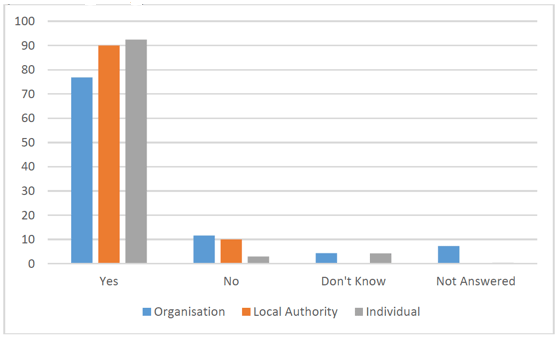
Overview
A total of 4,573 responses were received for this question. 92.6% of respondents agreed that there should be no statutory time limit for prosecuting offences under section 19 (unnecessary suffering) and section 23 (animal fighting). Meanwhile 3.1% of respondents disagreed with removing the statutory time limit for prosecuting offences under section 19 (unnecessary suffering) and section 23 (animal fighting).
Separating responses by respondent type showed that, of those who answered, the vast majority of organisations (82.8%),individuals (92.8%) and LAs (90%) agreed with the proposal.
Key themes from the individual responses included; crimes should be followed up regardless of the length of time elapsed since the offence; it can take considerable time to gather evidence and that time constraints would be detrimental in regard to obtaining successful prosecutions; there may be a strain on services with a limited statutory time limit; eliminating the statutory time limit would act as a deterrent and that each case should be treated individually.
Those that agreed
The general consensus for the organisations in favour of enforcing no statutory time limit for prosecuting offences under section 19 (unnecessary suffering) and section 23 (animal fighting) was that it will allow more time for investigations to be carried out, leading to more successful convictions and it will mean that new evidence of criminal activity committed in the past can be dealt with accordingly.
'Investigating a seasoned criminal means that gathering intelligence and evidence can take longer. If there was no statutory time limit then this would enable the best investigation possible to ensure a successful conviction' (Scottish SPCA)
The issue of being able to target repeat offenders, by means of no statutory time limit for prosecuting offences, was also raised by a number of respondents who mentioned reported links between abuse amongst people and animal abuse.
'Like child abusers, animal abusers are more likely to increase their offending the longer their crimes go unnoticed so prosecuting for historic crimes may stop current or future offending' (The pressure group Animal Concern and the charity Animal Concern Advice Line)
Of the Local Authorities in favour, the stretch on the authority resources that working within a short time limit imposes was mentioned. It is thought that unlimited timescales will give more chances for evidence gathering and successful convictions.
'…the Procurator Fiscal generally wishes the case to be submitted at 3 months to give them time to assess, mark and prepare. The practicalities of actually carrying out the investigation, collating the evidence, taking statements, obtaining and receiving expert witness statements mean that this can have a huge impact on Local Authority resources if the case has to be submitted in a very short timescale. If there are samples, post mortems to be examined then the results and associated reports can take time to be carried out and analysed' (Society of Chief Officers of Trading Standard in Scotland (SCOTSS)
Most local authorities were in support of enforcing no statutory time limit for prosecuting offences under section 19 (unnecessary suffering) and section 23 (animal fighting).
Those that disagreed
A common theme of organisations that were not in favour of the proposal was that it may further stretch the resources of the prison services or that it may lead to unnecessary delays to prosecutions for less serious offences.
Additionally, at least one respondent not in favour of the proposal took the opportunity to offer an alternative statutory time limit.
'I would suggest a 10 year limit since witnesses will be difficult to obtain and their reliability questioned after this period of time' (Northern Newfoundland Dog Club)
Question 6 – Do you agree the introduction of the proportionate fixed penalty notices would improve the enforcement of animal welfare offences?
Figure 7 - Breakdown of respondent groups to question 6 (%)
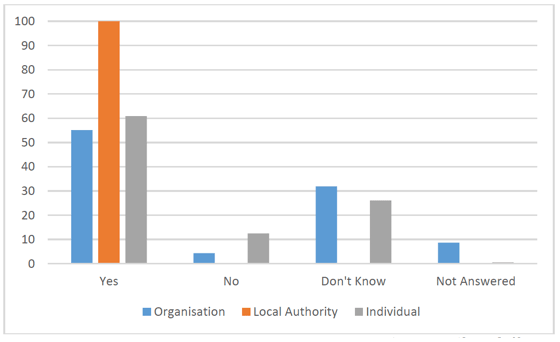
Overview
A total of 4,565 respondents answered this question and 61.4% of respondents agreed that the introduction of the proportionate fixed penalty notices would improve the enforcement of animal welfare offences. Meanwhile 12.4% of respondents disagreed.
Separating responses by respondent type showed that, of those who answered, a majority of organisations (60.3%) and individuals (61.2%) agreed with the proposal while LAs were unanimously in agreement that the introduction of the proportionate fixed penalty notices would improve the enforcement of animal welfare offences.
Key responses from individuals included; any FPNs should be a large sum to act as a deterrent; it would be a quick and effective way of dealing with offenses; FPNs should be used for lesser offences only; it would give more enforcement bodies more options; FPNs should be used alongside bans and that FPNs may reduce pressure on the Procurator Fiscal. There were concerns amongst individuals, however. It was thought that; a prison sentence may be more effective; FPNs may not be effective if the person is unable to pay and that for this reason it would not act as a deterrent.
The main themes within the responses from the organisations were: in comparison to a court case; it is a quicker and less expensive resolution; the FPN should relate to the nature of the crime; the definition of what nature of offense constitutes the award of an FPN be clearly outlined and that FPNs should only be used for minor offences only.
Those that agreed
Of the organisations in favour, a point was raised by one respondent relating to their particular sphere of expertise.
'This should also apply to commercial dog walkers walking more than 4 dogs at a time. The welfare of the dogs in good walkers' care should be a priority over potential earnings' (Professional Dog Walkers Association)
Support was raised on the basis of the convenience of instituting a Fixed Penalty Notice as opposed to a court case. The benefit of resource saving was stressed, in addition.
'Blue Cross believes that Fixed Penalty Notices (FPNs) are an effective means of changing behaviour….Used correctly, they could free time for the most serious cases to be brought before the courts and therefore save resources' (Blue Cross)
Within the comments from the local authorities there was support for Fixed Penalty Notices given their success in the past. It was highlighted that the repercussions for failing to pay should be outlined.
'Experience of fixed penalty notice provisions in other legislative areas e.g. tobacco sales enforcement, would suggest they are a very useful and effective enforcement tool. The consultation paper sets out the justification for introducing fixed penalty notices very well. Any new legislation should include a provision for dealing with the consequences for non-payment e.g. report to procurator fiscal' (West Lothian Council)
Those that disagreed
The organisations not supportive of the use of FPNs raised concern over the increased distribution of power to officials.
Additionally, although the question was 'not answered', the argument was raised that in an agricultural setting the existence of the cross compliance system contravenes with the issue of FPNs.
'…For offences involving livestock NFUS firmly believes that fixed penalty notices should not be considered…The penalties available through cross compliance will usually far outweigh the penalties available through the Animal Health and Welfare (Scotland) Act and can be applied without needing to undergo any court processes' (NFU Scotland)
Question 7 – Do you agree that there is a need to speed up the process of making permanent arrangements for animals taken into possession under section 32 of the Act?
Figure 8 - Breakdown of respondent groups to question 7 (%)
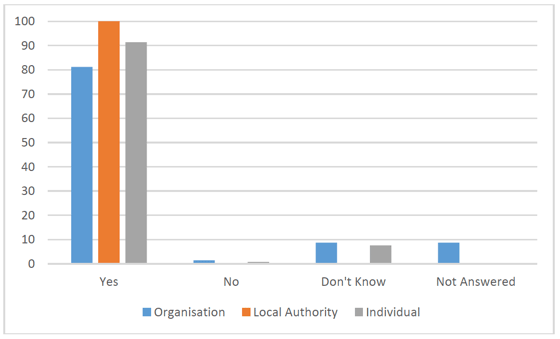
Overview
A total of 4,577 respondents answered this question and of those 91.6% agreed that there is a need to speed up the process of making permanent arrangements for animals taken into possession under section 32 of the Act. Meanwhile 0.8% of respondents disagreed.
Separating responses by respondent type showed that, of those who answered, the vast majority of organisations (88.9%) and individuals (91.6%) were in agreement with the proposal while Local Authorities responded unanimously in support of the proposal.
Key themes from individual responses included; speeding up the process of making permanent arrangements for animals taken into possession would prevent unnecessary suffering; it would speed up the potential for more socialisation opportunities for young animals outside of rehoming centres; the welfare of the animal was affected by prolonged lengths of time in temporary accommodation; animals were 'like children' and need stability; welfare centres were stretched (both financially and in terms of resources) with the volume of animals currently housed and that if there was sufficient evidence that the perpetrator was guilty the animals should be re-homed immediately.
Those that agreed
Of the organisations in favour, the common theme was that it was not beneficial to the animal to be held in temporary accommodation (e.g. a rescue centre/kennels) for an extended period of time as it is detrimental to their welfare. Organisations were generally in agreement that the welfare needs of the animal would be met more easily if permanent arrangements could be made sooner.
'…The animals' welfare can be compromised by delay' (Cani Sports Edinburgh)
It was stated that costs will be reduced if animals are held for a shorter period of time and, again, that resources would be freed up allowing animal rescue centres to care for more animals. A concern was also raised that the socialisation opportunities, particularly for young animals, in temporary homing centre were limited and that again it would be in the animals' best interests to be in a permanent home as early on in life as possible.
'IFAW's prime concern is the welfare of the animals in question and this should improve that, especially in the case of animals such as puppies which require a normal socialisation process in a domestic setting. A speeding-up of this process will also reduce costs on animal welfare organisations caring for animals in temporary placements and free up much needed places for new animals in need' (International Fund for Animal Welfare)
All respondents representing organisations, bar one, answered in favour of the proposal.
Amongst the comments from the local authorities, it was noted that not only is there increased pressure on animal charities in caring for animals long term but that the local authorities also face similar issues.
'The current process of applying for a disposal order can result in animals being cared for by LAs for excessive time periods. This can be resource intensive and costly for the LA. We fully agree that there is a clear need to speed up the process' (Highland Council)
Those that disagreed
Concerns were raised by respondents who did not agree, however, about the potential swift movement of livestock and the biosecurity implications. Further issues included the question of whether it would be more productive if the disposal of animals should be determined by bodies other than the courts.
In a 'Not Answered' response, concern was once again expressed about the potential swift movement of livestock.
'It is important to recognise that the ability to rehome livestock is limited and expensive….' (British Veterinary Association)
Question 8 – Do you agree that the ability to make suitable arrangements for animals taken into possession after service of a notice and after lapse of a specified period will benefit the welfare of animals?
Figure 9 - Breakdown of respondent groups to question 8 (%)
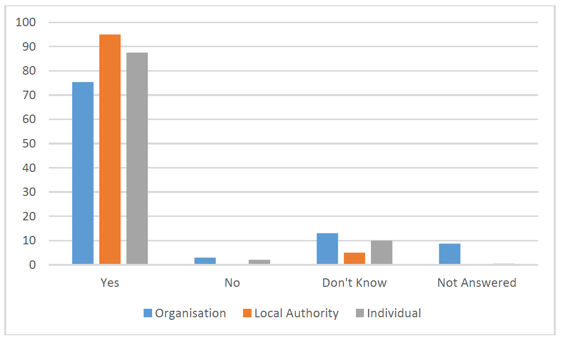
Overview
A total of 4,568 responses were received for this question and of these 87.9% of respondents agreed that the ability to make suitable arrangements for animals taken into possession after service of a notice and the lapse of a specified period will benefit the welfare of animals. Meanwhile 2.1% of respondents disagreed.
Separating responses by respondent type showed that, of those who answered, the vast majority of organisations (82.5%), individuals (87.9%) and LAs (95%) were in agreement with the proposal.
Key themes from individual responses included; the ability to speed up the process of making permanent arrangements for animals taken into possession would reduce stress in the animal; it would improve the animals' rehoming prospects; one should ensure the animal was rehomed to the correct home and that the animal should then continue to be monitored to ensure that the welfare of the animal has improved.
Those that agreed
Of the organisations in favour, certain respondents made suggestions of maximum lengths of time for animals to remain in possession after service of a notice.
'Cats Protection believes that there should be a specified period as this will benefit the short-term welfare of the animal…The charity recommends that a reasonable amount of time would be within a month' (Cats Protection)
The negative impacts of housing animals in short term accommodation for lengthy periods of time, including the stressful nature of being in an unfamiliar environment and of being in close contact with unfamiliar animals, were outlined by certain organisations.
'….Whilst every effort is made to make an animal's time in kennels as stress free as possible, kennelling, particularly for dogs and cats can be a stressful environment with animals in unfamiliar surroundings and in close proximity to others….' (Battersea Dogs and Cats Home)
All respondents representing local authorities, bar one, answered in favour of the proposal. Again it was recognised that swifter action would benefit the complex needs of the animal.
'The new proposed measures can only benefit the physical and psychological welfare of animals' (Scottish Borders Council)
Those that disagreed
Overall, the respondents not in support expressed some confusion around the term 'disposal'. Some respondents interpreted the word to mean the physical destruction of the animal. This may account for some of the responses against the proposal.
Question 9 – Do you agree that the ability to make suitable arrangements for these seized animals after a short period will free up resources of the relevant enforcement authorities and animal welfare charities; allowing them to help a greater number of animals?
Figure 10 - Breakdown of respondent groups to question 9 (%)
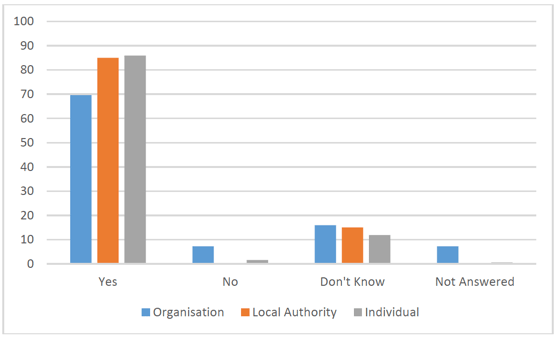
Overview
A total of 4,564 responses were received for this question and of these 86.3% of respondents agreed that the ability to make suitable arrangements for seized animals after a short period will free up resources of the relevant enforcement authorities and animal welfare charities; allowing them to help a greater number of animals. Meanwhile 1.7% of respondents disagreed.
Separating responses by respondent type showed that, of those who answered, the majority of organisations (75%), individuals (86.4%) and LAs (85%) were in agreement with the proposal.
Key themes from individual responses included; it was believed that welfare charities were overwhelmed and underfunded so the proposals would be a welcome change; temporary accommodation is not always suitable and that any animal welfare related fines collected should go back into caring for the animal that was taken into possession.
Those that agreed
Of the organisations in favour, it was emphasised that freeing up space in rescue centres, through the ability to find permanent homes for animals more quickly, would allow more animals to be helped. In addition the fact that behavioural issues caused by extensive periods of time spent in temporary housing, such as kennels, affects rehoming prospects was emphasised.
'The Scottish SPCA's animal rescue and rehoming centres end up at near capacity due to the temporary refuge of animals (animals involved in active court proceedings) …This has a knock on effect on the number of animals the society can help. Despite our staff's significant efforts, having animals housed for months if not years has a significant impact on their mental and physical well-being which can lead to behavioural problems that subsequently affects their ability to be rehomed when the time comes' (Scottish SPCA)
Of the local authorities in favour it was generally believed that more resources would be freed up, thereby enabling an increased number of animals to be helped. However, some concerns in terms of the clarity of the legislation were highlighted.
'We support an effective legislative regime which ensures the enforcement agencies are protected from any repercussions from resettling animals. We would also seek clarity on this power by means of legislation' (Stirling Council)
Further discussion points were raised by respondents that the number of appeals may ultimately affect whether more space can be freed up in rescue centres.
'…whether this does free up resources as intended will depend, in large part, on how many people appeal against notices…' (Scottish Countryside Alliance)
Those that disagreed
Of those not in support, doubts were cast by some respondents over the lack of resources in animal rescue and rehoming centres to care for large numbers of seized animals at any one time.
'In all truth I have grave doubts that you will be able to make suitable arrangements for said seized animals unless you set up a statutory body to be responsible for the care of the animals and their re-homing' (Mossburn Community Farm)
A further concern was noted by a local authority respondent who answered 'Don't know'. This was the idea that animal welfare charities will be able to help a greater number of animals yet it is disputed whether the proposal will mean that local authorities can help a greater number of animals in the long run. It was highlighted that the swift rehoming of animals would allow the authorities more time to carry out other activities, however:
'For the SSPCA or a charity, this could be the case but the duties of LA officers are more complex…..By reducing the period for caring for the animals from seizure to the actions of a disposal order, this will save time, resources and costs. However, it is unlikely that this time will allow us to help a greater number of animals. What it will do, is allow us to deliver our statutory duties and or animal health and welfare service plans' (Angus Council)
Although some LAs responded with the 'Do Not Know' option (15%), no respondents representing local authorities answered against the proposal.
Question 10 – Should such a new power to make permanent arrangements for animals that have been taken into possession apply to all animals, or only to commercially kept animals; such as puppies in breeding facilities, puppies for sale and livestock?
Figure 11 - Breakdown of respondent groups to question 10 (%)
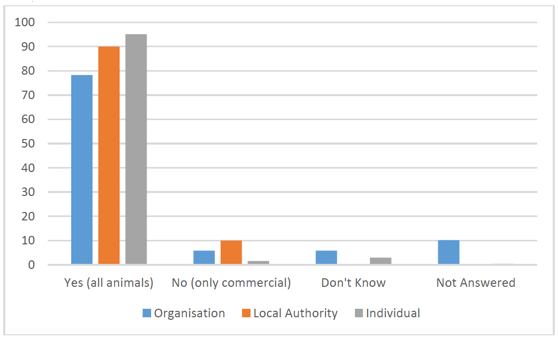
Overview
A total of 4,569 responses were received for this question and of these 95.4% of respondents considered that such a new power to make permanent arrangements for animals that have been taken into possession should apply to all animals. Meanwhile 1.7% of respondents thought that such a new power should apply to commercially kept animals only; such as puppies in breeding facilities, puppies for sale and livestock.
Of the organisations who responded to this question, 54 (87.1%) considered that such a new power to make permanent arrangements for animals that have been taken into possession should apply to all animals, with 4 other organisations (6.5%) considering that it should apply to commercially kept animals only.
Of the LAs who responded to this question, 18 (90%) considered that such a new power should apply to all animals, with 2 other respondents (10%) considering that it should apply to commercially kept animals only.
Of the individuals who responded to this question, 4,286 respondents (95.5%) considered that a new power to make permanent arrangements for animals that have been taken into possession should apply to all animals, with 70 other individuals (1.6%) considering that it should apply to commercially kept animals only.
Key themes from individual responses who replied 'Yes, all animals' included; animals should not be treated differently; animal abuse can occur in any species and not just commercial animals and that the belief that all animals are sentient was raised to support the agreement that such a new power to make permanent arrangements for animals that have been taken into possession should apply to all animals.
Those that answered (all animals)
Of the organisations in favour of the proposal applying to all animals, the common theme was that again respondents did not believe that it was morally right to hold certain animals in higher repute than any other animal. There was the philosophical argument that some animals may receive more 'rights' resulting in other species receiving unequal treatment. Additionally, many respondents believed that welfare for all animals would be improved further if the proposal applied to all species.
'This should apply to all animals to ensure that their wellbeing is maximised across the board.' (The People's Dispensary for Sick Animals (PDSA)
Perspectives from organisations involved with a focus on specific species were gathered. In particular, the implications of the proposal regarding the multiple uses for horses were emphasised – e.g. pets, breeding stock, competition animals etc.
'This power should apply to all animals. In the horse world multi-horse homes frequently get into bother but they are not commercial as such – they are often enthusiastic keepers with no sense or collectors but certainly private and therefore these 'hoarders' need to be dealt with by having their poor animals seized where possible. The definition of commercial is also unclear in an equine setting…' (British Horse Society Scotland)
Some local authorities were concerned that if the proposed amendment applies to commercial animals only, owners could falsely claim that their animals were pets to evade the legislation.
'This legal power should apply to all animals; if it is restricted to only commercial animals then animal breeders including farmers may claim that specific animals are pets and not commercial animals, creating a potential loophole in the legislation' (North Lanarkshire Council)
Those that answered (commercial animals only)
Of those in favour of the proposal applying to commercially kept animals only, concerns were raised that the definition of commercial animals should be carefully defined.
'This rather depends on how you define "commercial"? HMRC defines it as making less than £1,000 per annum…As a Club, our members breed their birds as a stud but given that all make a loss on the process, is that non-commercial?' (The Scots Fancy Specialist Club)
Of the local authorities in favour of such a new power to make permanent arrangements for animals that have been taken into possession to apply to commercially kept animals only, again it was outlined that 'commercial animals' should be carefully defined. It was also stated that legislation in regard to pet owners was perhaps too ardent at present.
'Private animal/pet owners need to be protected against overzealous, overly robust enforcement……It was agreed that there would have to be clear guidance on what could be considered commercial.' (Aberdeenshire Council)
Question 11: Do you agree that the owner or previous keeper should have an opportunity to appeal against permanent arrangements being made within a short time period?
Figure 12 - Breakdown of respondent groups to question 11 (%)
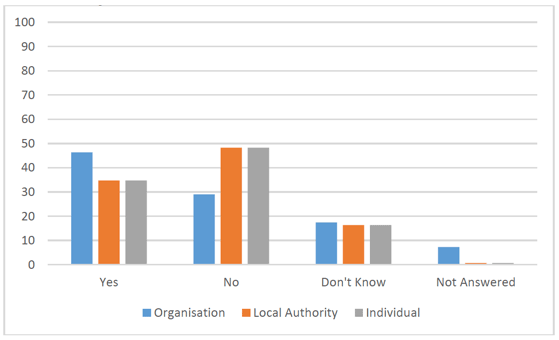
Overview
A total of 4,558 responses were received for this question. Of these 35.5% of respondents agreed that the owner or previous keeper should have an opportunity to appeal against permanent arrangements being made within a short time period. Meanwhile 48.2% of respondents disagreed.
Separating responses by respondent type showed that, of those who answered, 50% of organisations, 35% of individuals and 35% of LAs were in agreement with the proposal.
A higher proportion of organisations voted in favour compared to the individual responses.
Those that agreed
Key themes from individual responses for those who responded in favour included; the previous keeper has the right to appeal in the interests of fairness; an appeal is permissible only if there is a genuine case; appeals should be carried out within a short time frame only; an appeal should only be carried out if there is a behavioural change in the perpetrator; mistakes may be made if there is no right to appeal and that an appeal may only be carried out depending on the nature of the crime.
The common theme within organisations in favour of the proposal was that, in the interest of fairness, the previous keeper would have the chance to appeal against any permanent arrangements made. This was the general consensus but many respondents raised the point that this would be on the proviso that there would be no doubt that the keeper would be able to meet the welfare needs of the animal and that there would be no further offences.
'A vulnerable animal should be removed as soon as possible, but the guardian/owner should be able to give their side of the matter. That is just and fair' (Catholic Action for Animals)
Furthermore, a time limit was suggested about the time within which an owner should be permitted to appeal. Models from other countries were referred to as a guideline.
'Yes, as long as any appeal can be dealt with in a very short period of time, such as the Swedish model (3 weeks). The Swedish model only allows for the potential accused to appeal for the commercial value of the animals (as of the time they were seized)' (Scottish SPCA)
Of the local authorities in favour, again the issue of fairness was reiterated.
'This would be in the interests of fairness' (Dumfries and Galloway Council)
Ongoing monitoring of the animals after or during an appeal was an additional suggestion from LAs.
'A process of appeal is correct; but the welfare situation of the animals concerned must be monitored so that any further suffering can be properly assessed in relation to an appeal being made' (East Ayrshire Council)
Those that disagreed
Some individual responses expressed concern. This included; if there is any indication that the person has caused suffering they should relinquish the right to an appeal; once a person has abused an animal they are 'always an abuser'; the perpetrator may have no 'second chances'; appeals prolong the rehoming chances and that again an appeal may be allowed depending on the seriousness of the crime.
Those not in support of the main theme seemed to consider that once there was proof of the mistreatment of an animal, the keeper should automatically relinquish the right to own any more animals in the future.
'If an animal needs rehoming for its welfare, the owner should have no further rights' (Dumyat Kennels)
The way in which the question was interpreted may have influenced whether the respondents had answered in agreement or not. Many of those who answered in agreement did so on the proviso that previous keeper had been found not guilty or that there was evidence that the individual had made significant behavioural changes to the way they cared for the animal. Meanwhile, many of those who did not answer in agreement also made an exception in cases where the previous keeper had been found not guilty or that there was evidence that the individual had made significant behavioural changes in their care for the animal. The intention of the new powers allowing rehoming would be irrespective of any prosecution, would not depend on an owner being found guilty or innocent, and would, in most cases, be undertaken before a prosecution came to court.
Question 12: Do you agree that three weeks is a reasonable period of notice before making suitable permanent arrangements for animals taken into possession?
Figure 13 - Breakdown of respondent groups to question 12 (%)
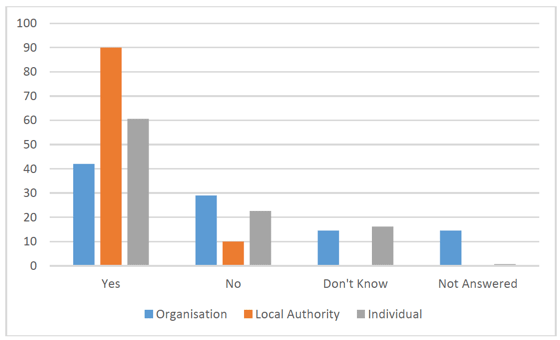
Overview
A total of 4,556 responses were received for this question. Of these 61% of respondents agreed that three weeks is a reasonable period of notice before making suitable permanent arrangements for animals taken into possession. Meanwhile 22.8% of respondents disagreed.
Separating responses by respondent type showed that, of those who answered, 49.1% of organisations agreed. The majority of individuals (61%) and LAs (90%) agreed.
Those that agreed
Key themes from individual responses for those who agreed included; agreement that three weeks was a suitable time frame; three weeks was a suitable time frame but only if the time for appeal was included; although the time period was suitable it depends on the veterinary treatment required/depended on the individual situation; the three week period of notice would subsequently mean that space could be freed up more quickly in rehoming centres; it was detrimental to the welfare of the animal to be kept for long periods of time in rehoming centres and that animals were 'like children' and needed protection.
Of the organisations in favour, the common theme was that this was a suitable length of time in which to not cause too much undue stress to the animal and in which to give the keeper the right to appeal. It was highlighted that perhaps an appeal could extend this time limit, however.
'Three weeks is sufficient time for a keeper to make arrangements to appeal the notice. We assume that an appeal would trigger extension of the period but this should be kept to a minimum' (OneKind)
Of the local authorities in favour, the cost saving benefit of a three week period of notice was noted.
'This gives a local authority or animal welfare organisation time to make arrangements without incurring excessive expense and recognises the right of appeal of the legal owner of the animal' (North Lanarkshire Council)
Those that disagreed
Key themes from individual responses for those who disagreed with the proposal included; the period of notice should be quicker still (some respondents suggested different time frames – less than 7 days, 10 days, 2 weeks etc.); the animal should be removed as soon as possible; each case needed to be dealt with individually and that a longer time period (e.g. 4 weeks) may be beneficial for some (such as those living in rural areas who relied on infrequent public transportation).
Of those not in support of the three week time period, other lengths of time were advised, as mentioned. It also was argued that each case would require a more flexible time scale be used. Implications were raised that the timescale should correspond to being whatever was in the best interests of making permanent arrangements for the animal as soon as possible.
'Each case should be treated individually and depending on circumstances there should be no fixed time schedule for permanent rehoming. Arrangements to a suitable place of care should be in place as quick as possible' (Rhuallan Raptors)
Furthermore, timescales were suggested with the view to minimising stress to the animal.
'We propose that a 10 day period of notice would be more suitable, as it would minimise stress for the animals who have been taken into possession and reduce costs for the authority caring for them' (PETA Foundation)
In addition, it was suggested that the time period should vary according to the needs of different animal species.
'Four weeks will be more fitting for an equestrian setting to allow owners to be traced, arrangements to be made and evidence collected' (British Horse Society Scotland)
Of the local authorities not in support of the three week time period, again other lengths of time were suggested in terms of having more time to analyse the case.
'28 days would be a reasonable period in which to allow local authorities to make the best provisions for the care of the animals in all circumstances. This would also allow for time to gather all available evidence to support any anticipated proceedings' (Aberdeenshire Council)
The organisations were not in agreement with the proposal, overall. This may be due to the differing opinions of the time frame suggested. The amount of species specific groups could dictate this – with many organisations tailoring the time frame to suit the species or perhaps to suit the general needs of the organisation. It may also be that some respondents misunderstood the 3 week timescale. Many of those disagreeing seemed to think that the animals must be rehomed after 3 weeks, rather than the intention being that they can be rehomed after 3 weeks.
Question 13: Do you agree that the previous keeper should be able to apply for compensation based on the commercial value of these animals, less reasonable costs?
Figure 14 - Breakdown of respondent groups to question 13 (%)
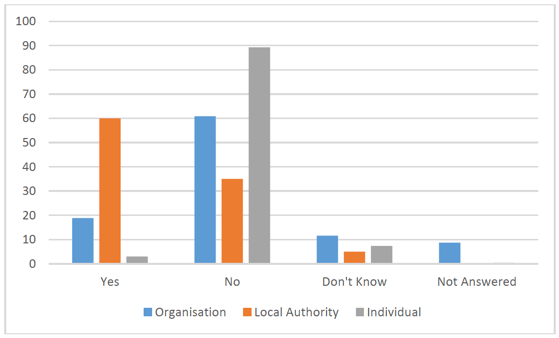
Overview
A total of 4,570 responses were received for this question and of these 3.5% of respondents agreed that the previous keeper should be able to apply for compensation based on the commercial value of these animals, less reasonable costs. Meanwhile 89% of respondents disagreed.
Separating responses by respondent type showed that, of those who answered, a minority of organisations (20.6% ) and individuals (3%) agreed with the proposal while 60% of LAs agreed.
Key themes from individual responses included; if the person was guilty of animal abuse that they have then lost the rights to any compensation; a person should not be 'rewarded' – by means of compensation- for their actions if they are found guilty of animal abuse; the person 'chose to abuse' and hence are not entitled to compensation; compensation may be awarded on the proviso that the person is found not guilty and that the money available for the proposed compensation could instead be used to recuperate costs for animal welfare charities.
Those that agreed
Of the organisations in favour, it was raised that the previous keeper should be eligible for compensation but if guilty they became a perpetrator who should be penalised also. Moreover, it was argued by some respondents that the commercial value – some of whom stated that this should be of the value at the time of seizure only and some did not specify - of the animal should be compensated only.
'We support the ability to recover compensation, less reasonable costs, but we would also note that where an owner is subsequently acquitted of any wrong doing they are still obligated to pay costs and as such are penalised' (Scottish Countryside Alliance)
It was also raised that compensation should be sought by a keeper found not guilty.
'The circumstances need to be more clearly set out as it would seem illogical to compensate a previous keeper if they were the person involved in the failure to provide for the animals' welfare' (The Law Society of Scotland)
Of the local authorities in favour, the point was raised that the description of the compensation entitlement and reasonable costs be clearly defined.
'Clarification of compensation and what it actually entails is important…' (South Lanarkshire Council)
Another comment from a local authority, mentioned alongside support for compensation entitlement is that there is a sizeable financial burden which is associated with animal care. It is believed that a local authority should be able to seize an animal, if necessary, without the worry of the financial implications.
'Yes a previous owner should be able to apply for compensation where they can justify a significant loss due to their animals being seized…The act of seizing animals found in distress, is designed to alleviate suffering without the thought of the financial implications for the seizing authority, and as such there should be some mechanism to recoup costs incurred quickly and efficiently to aid further funding for continued animal welfare enforcement capabilities in the future…' (Shetland Islands Council)
Those that disagreed
Of those not in support, respondents were concerned over the circumstances under which compensation would be given.
'If the previous owner has been found guilty of the crime then confiscation of the animals should be without compensation. If the previous keeper is subsequently exonerated then compensation might be necessary' (Jeanne Marchig International Centre for Animal Welfare Education)
Concern was raised about how the term 'reasonable costs' would be defined. Respondents also questioned what funding body would provide the compensation.
'…Unless animals are sold we would question who would fund any compensation and how reasonable costs could possibly be defined given the very variable and sometimes extensive costs involved in rehabilitating a horse for example' (Redwings Horse Sanctuary)
Of the local authorities not in support, in addition to not providing compensation it was also believed that any revenue made illegally should be seized. Again, there was support that compensation should not be given for those found guilty of welfare violations and that the term 'reasonable costs' should be defined.
'Compensation should not be available to a former owner or keeper convicted of welfare offences.….Reasonable costs must be defined within statutory guidance. If there is no value left in the animals after they have been sold, then the enforcing authority should be allowed to recover any costs from the former owner or keeper' (West Lothian Council)
Again, the way in which the question was interpreted may have influenced whether the respondents had answered in agreement or not. Many of those who answered in agreement of the provision of compensation did so on the understanding that the previous keeper had been found not guilty. Meanwhile, many of those who did not answer in agreement of the provision of compensation made an exception in the
comments for cases where the previous keeper had been found not guilty.
Question 14: Do you have any practical suggestions about how to value commercially kept animals other than farm livestock?
Separating responses by respondent type showed that 36 organisations responded with comments and 13 LAs responded. 2,010 individuals responded with textual responses.
Key themes from individual responses included; the market value be used; a 'specialist valuer' may be used; advice from an auctioneer or charity should be sought; the advice of a vet may be used; a panel of experts in the field could determine the value; the life expectancy of the animal or the level of care needed for the animal may be used as an estimation and that health or genetic testing could determine the value. Several individuals commented again that they thought no compensation should be awarded under any circumstances.
Of the organisations offering comments, common suggestions were; using insurance companies to value pets; using bodies such as the Kennel Club; pet shop valuations; using fixed rates for a particular species to avoid inflating the values due to breeding potentials; using vets and basing the value on rehoming fees. There was also concern expressed that previous keepers may inflate the value of the animals.
'…It is more problematic when dealing with commercial pet species (such as puppy farmed animals), these are often valued by the previous owner at a far higher rate than is the reality' (Scottish SPCA)
The use of specific industry professionals or independent valuers were other suggestions made by respondents. This could be particularly useful for animals which are used for different purposes – i.e. horses as mentioned.
'If you had to value a horse (which is not easy) you could use an industry professional from the higher lever (Stage 4 or above) internationally recognized Accredited Professional Coach system of which there are hundreds across Scotland…' (British Horse Society Scotland)
In addition to the support for using insurance companies to value animals, the use of a forensic accountant was also mentioned as another potential method.
'We would encourage the Scottish Government to consult with pet insurance companies who provide theft insurance, and routinely provide valuations of pets. For animals which are kept in commercial settings whereby loss of income will also need to be considered, the services of a forensic accountant may be required' (The Kennel Club and Scottish Kennel Club Society)
One suggestion was holding regular focus groups with stakeholders as breed prices change over time. It was suggested that an average could be obtained from this valuation. Suggestions were also given as to under which particular circumstances dogs should be valued higher or lower.
'…Extra weighting should be given to service and assistance dogs to account for the costs that go into their training. Extra weighting may be given where pre-breeding health tests have taken place such as those by Kennel Club Assured breeders. We believe no extra weighting should be given to: Kennel Club registered dogs, given that any dog can be registered…..The future potential 'breeding value' of the dog' (Dogs Trust)
Of the local authorities with suggestions, the ideas included; using boarding fees as a valuation method; rehoming fees; ascertaining the market value perhaps by means of analysis of adverts online; and keeping electronic records was one comment from a respondent.
'Full record keeping of all sales and purchases, logged on a centralised, independent register' (Community Council)
Suggestions were given in relation to business related tools which could be consulted about the valuation of commercial animals. Another point for consideration was the use of the Institute of Auctioneers and Appraisers in Scotland to produce a valuation.
'..Equine pedigree societies are another source of information. Certain organisations use a value matrix to assess likely worth and give a notional value to stock. The IAAS can provide independent professional valuation of most commodities especially livestock/horses/dogs' (Aberdeenshire Council)
Question 15: Please provide any further comments or suggestions on the proposed new system for making permanent arrangements for animals.
Separating responses by respondent type showed that 33 organisations responded and 11 LAs responded. 1,255 individuals responded with textual responses.
A variety of different comments were made by respondents, not all of which related specifically to the question asked.
Key themes from individual responses included; foster homes should be used for the animals as an interim; the government should provide financial assistance to rehoming centres; lottery funding should be sought for rehoming centres; the time given for appeals should be shortened; spot checks for animals after rehoming should be carried out; any fines received as a result of animal abuse should go back to rehoming centres and that advice from a vet should be sought about permanent arrangements for animals.
Comments on Making Permanent Arrangements for Animals
Comments from organisations relating specifically to making permanent arrangements for animals included concerns that the whereabouts of an animal, victim to an abuse case, should not be able to be traced after permanent housing arrangements are made.
'….We firmly believe that any new system for making permanent arrangements for animals, should ensure that animals cannot be tracked when rehomed...We also believe that a national animal offender register, accessible by all enforcement agencies, would greatly assist in combating animal welfare crimes and breaches of the Act…' (Edinburgh Dog and Cat Home)
Comments were made specifically about dogs held under the Dangerous Dogs Act. It was noted that they too are spending longer than is necessary in temporary accommodation.
Comments on Other Amendments to the Act
Comments relating to other amendments to the Act included a register of offenders, which was suggested by a number of respondents and noted to have other uses outside of targeting persistent abusers of the Act. It was mentioned by respondents that it could also be used as a link to people who are also involved in other criminal offences such as domestic abuse crimes. The use of the register to target those breaching the Control of Dogs legislation was also referred to, with the objective of targeting dog attacks on livestock and to prevent those with previous convictions from obtaining a breeding license.
'Cats Protection recommends that all animal welfare offences should be recorded on a National Animal Offenders Register across the UK…It would be essential that all authorised enforcement agencies have ready access to the register' (Cats Protection)
Concern was also highlighted that FPNs should not be in conflict with other similar notices, such as the statutory care notices.
Wider Comments
Concerns were raised as to the effectiveness of the current legislation, on the basis of the belief that it is perhaps more reactive than proactive. Criticism was again made of the knowledge of officers inspecting establishments and further training was suggested once more.
'….We have serious concerns that inspections of these establishments are currently often conducted by local authority officials with no or limited knowledge of animal welfare….We therefore recommend the Scottish Government develop a central unit of appropriately trained inspectors which can be utilised by all local authorities to carry out inspections of animal establishments…' (Dogs Trust)
Common comments from Local Authorities included; further concerns that more training should be given to staff involved in enforcing the Act; the clarity of the powers of entry/re-entry was highlighted and again the idea of a database of offenders was offered.
'Better training for officers on the removal of animals. Better communication between agencies. Better networks across the country for moving these animals to safe places. A national database of providers of permanent care' (Stirling Council)
Additionally, the time required to obtain a warrant for entry or re-entry of a premises was flagged as a point of concern. It is noted too that consideration should be given to any key stakeholders involved, ensuring that all relevant organisations are able to carry out their required roles free from conflict and within their level of enforcement power.
One LA respondent offered issues with farm inspections under the current Animal Health & Welfare (Scotland) Act 2006. The concern was that officers were required to obtain a warrant prior to collecting evidence, which could often necessitate leaving distressed animals in place while a warrant was obtained. It was suggested that further training be given to farm inspectors as to how to enforce powers. Further concern was raised about the practicalities of obtaining a warrant for remote farms in particular.
Contact
Email: Phil.Burns@gov.scot
There is a problem
Thanks for your feedback